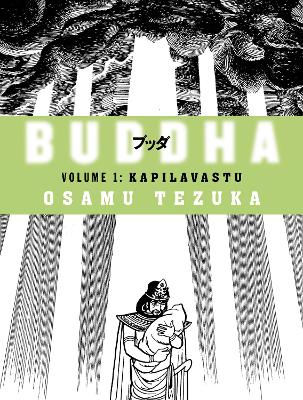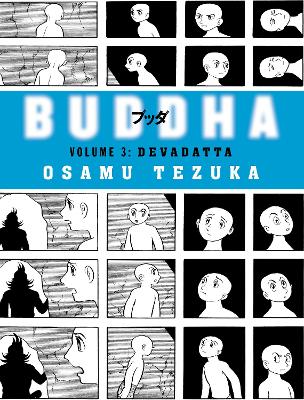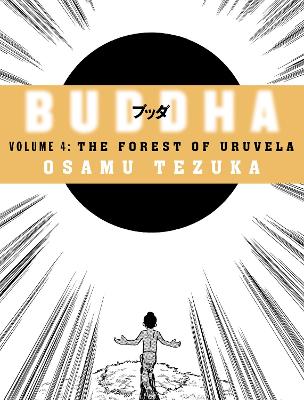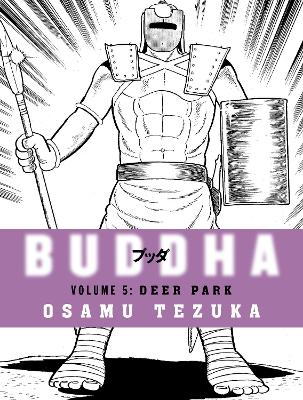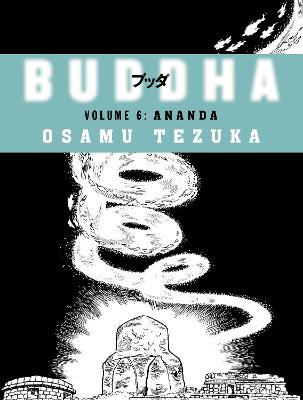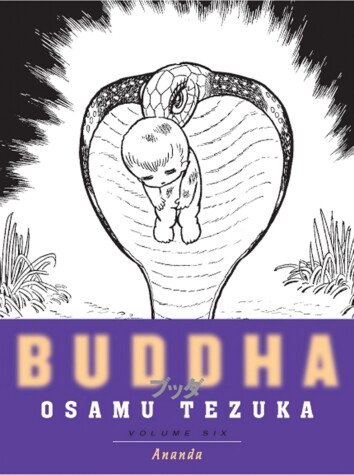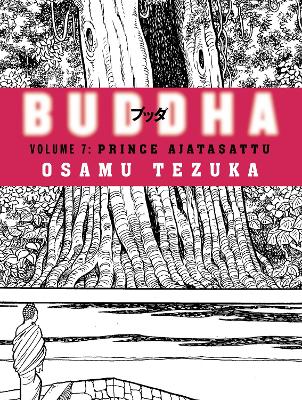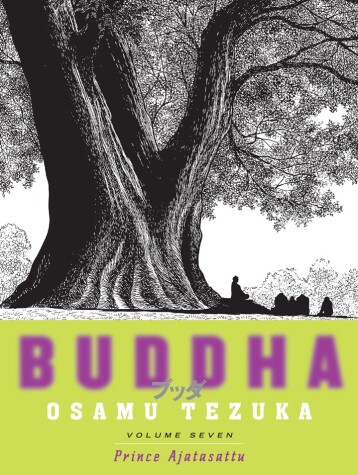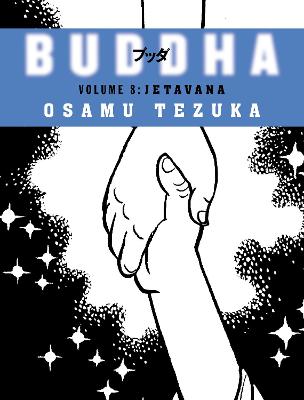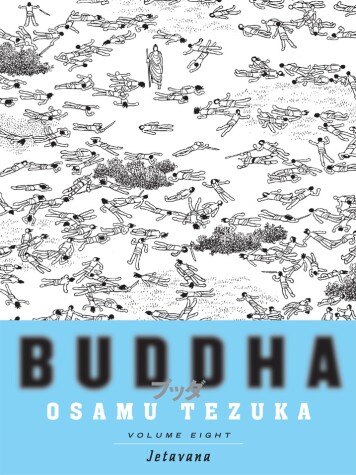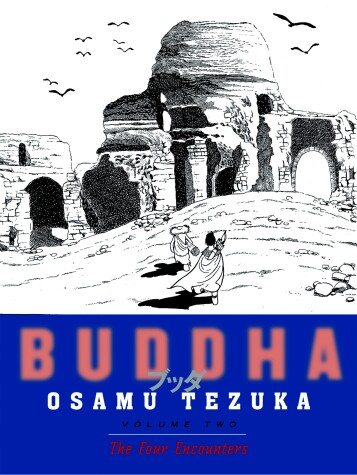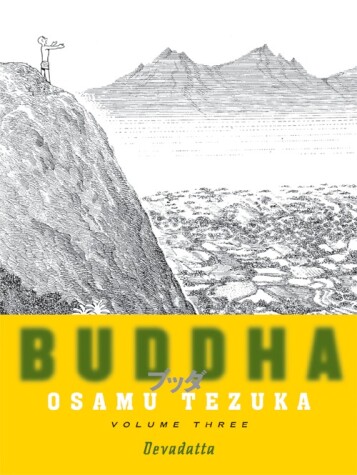Buddha
11 primary works • 13 total works
Book 1
The first book in the classic eight volume graphic novel series from the godfather of the genre – an irreverent and humourous rendition of the life and times of Buddha.
In book one, Kapilavastu, Chapra, an ambitious slave, spurns the caste system into which he was born and tries to become a nobleman, Tatta, the wild pariah child, communes with animals, and the monk, Naradatta, strives to uncover the meaning of strange portents surrounding the Buddha’s birth.
Originated in the 1970s, Buddha is Osamu Tezuka's unparalleled rendition of the life and times of Prince Siddhartha.
Tezuka's storytelling genius and consummate skill at visual expression blossom fully as he contextualizes the Buddha's ideas; with an emphasis on action, emotion, humour and conflict as Prince Siddhartha runs away from home, travels across India and questions Hindu practices such as ascetic self-mutilation and caste oppression.
Rather than recommend resignation and impassivity, Tezuka's Buddha predicates enlightenment upon recognizing the interconnectedness of life, having compassion for the suffering, and ordering one's life sensibly, his approach is slightly irreverent in that it incorporates something that Western commentators often eschew, namely, humour.
Book 2
The second book in the classic eight volume graphic novel series retelling the story of Buddha, from the godfather of the genre - an irreverent and humourous rendition of the life and times of Prince Siddhartha.
In book two, The Four Encounters, Prince Siddartha - fated to become the Buddha - is confronted by the harsh penalties of social injustice within his own kingdom, fuelled by selfish warlords and villains like the depraved warrior, Bandaka. The tragic fortunes of his loved-ones, such as Tatta the rogue and Migalia the fierce female bandit, force the Prince to choose between love and destiny; Siddartha must forsake his heart and begin his pilgrimage.
Originated in the 1970s, Buddha is Osamu Tezuka's unparalleled rendition of the life and times of Prince Siddhartha.
Tezuka's storytelling genius and consummate skill at visual expression blossom fully as he contextualizes the Buddha's ideas; with an emphasis on, action, emotion, humour and conflict as Prince Siddhartha runs away from home, travels across India and questions Hindu practices such as ascetic self-mutilation and caste oppression.
Rather than recommend resignation and impassivity, Tezuka's Buddha predicates enlightenment upon recognizing the interconnectedness of life, having compassion for the suffering, and ordering one's life sensibly, his approach is slightly irreverent in that it incorporates something that Western commentators often eschew, namely, humour.
Book 3
The third book in the classic eight volume graphic novel series retelling the story of Buddha, from the godfather of the genre.
In the third of the Buddha series, as Siddhartha embarks on his journey towards enlightenment, he encounters many influences; some forceful, like the monk Dhepa who believes that purity is only attained through ordeals of the flesh, and some inspirational, like the strange young acolyte, Assaji.
Meanwhile, Devadatta, the young orphaned son of Bandaka, is forced along a cruel path. Choosing to reject humanity and compassion, Devadatta’s journey will mould him into Buddha’s greatest adversary.
Originated in the 1970s, Buddha is Osamu Tezuka's unparalleled rendition of the life and times of Prince Siddhartha.
Tezuka's storytelling genius and consummate skill at visual expression blossom fully as he contextualizes the Buddha's ideas; with an emphasis on, action, emotion, humour and conflict as Prince Siddhartha runs away from home, travels across India and questions Hindu practices such as ascetic self-mutilation and caste oppression.
Rather than recommend resignation and impassivity, Tezuka's Buddha predicates enlightenment upon recognizing the interconnectedness of life, having compassion for the suffering, and ordering one's life sensibly, his approach is slightly irreverent in that it incorporates something that Western commentators often eschew, namely, humour.
Book 4
The fourth book in the classic eight volume graphic novel series retelling the story of Buddha, from the godfather of the genre.
In book four, unfulfilled by the teachings of renowned ascetics, Siddhartha agrees to follow Dhepa into the forest of trials. But the final ordeal of little Assjai proves to be his most poignant lesson.
As Siddhartha searches his heart and yearns for his family, the Kosalans discover the true caste of their queen – a despised shudra, disguised as a noble kshatriya. For the insult, the Buddha’s homeland will pay dearly.
Originated in the 1970s, Buddha is Osamu Tezuka's unparalleled rendition of the life and times of Prince Siddhartha.
Tezuka's storytelling genius and consummate skill at visual expression blossom fully as he contextualizes the Buddha's ideas; with an emphasis on, action, emotion, humour and conflict as Prince Siddhartha runs away from home, travels across India and questions Hindu practices such as ascetic self-mutilation and caste oppression.
Rather than recommend resignation and impassivity, Tezuka's Buddha predicates enlightenment upon recognizing the interconnectedness of life, having compassion for the suffering, and ordering one's life sensibly, his approach is slightly irreverent in that it incorporates something that Western commentators often eschew, namely, humour.
Book 5
The fifth book in the classic eight volume graphic novel series retelling the story of Buddha, from the godfather of the genre.
In book five, rising from the shade of the Pippla tree, Buddha must spread the word of Brahma to his fellows, be they human or animal. He will confront Devadatta's ruthless ambition, soothe Tatta's thirst for revenge and will even reach out to the stubborn monk Dhepa. But forgiving the Kingdom of Kosala for the devastation wreaked upon his homeland could prove to be Buddha's greatest challenge yet.
Originated in the 1970s, Buddha is Osamu Tezuka's unparalleled rendition of the life and times of Prince Siddhartha. Tezuka's storytelling genius and consummate skill at visual expression blossom fully as he contextualizes the Buddha's ideas, with an emphasis on action, emotion, humour and conflict as Prince Siddhartha runs away from home, travels across India and questions Hindu practices such as ascetic self-mutilation and caste oppression. Rather than recommend resignation and impassivity, Tezuka's Buddha predicates enlightenment upon recognizing the interconnectedness of life, having compassion for the suffering, and ordering one's life sensibly. Furthermore, his approach is slightly irreverent in that it incorporates something that Western commentators often eschew, namely, humour.
Book 6
The sixth book in the classic eight volume graphic novel series retelling the story of Buddha, from the godfather of the genre.
In book six, as Kapiluvastu burns and it's people are hunted down, an infant refugee – Ananda – is granted the gift of invincibility by Mara, an evil demon. Nurtured by the she-devil, Ananda learns to use his power to become a fearsome bandit, honing his cruelty and selfishness before he is unleashed upon the demon's enemy: Buddha.
Originated in the 1970s, Buddha is Osamu Tezuka's unparalleled rendition of the life and times of Prince Siddhartha. Tezuka's storytelling genius and consummate skill at visual expression blossom fully as he contextualizes the Buddha's ideas, with an emphasis on action, emotion, humour and conflict as Prince Siddhartha runs away from home, travels across India and questions Hindu practices such as ascetic self-mutilation and caste oppression. Rather than recommend resignation and impassivity, Tezuka's Buddha predicates enlightenment upon recognizing the interconnectedness of life, having compassion for the suffering, and ordering one's life sensibly. Furthermore, his approach is slightly irreverent in that it incorporates something that Western commentators often eschew, namely, humour.
Book 6
When Ananda and his bandit buddy attack the Fire Shrine of the Brahmin brothers Kassapa, it is none other than the Awakened One who happens by. Buddha must confront his eternal enemy, Mara, before he can open the eyes of arrogant priests and hardened criminals.
Book 7
The seventh book in the classic eight volume graphic novel series retelling the story of Buddha, from the godfather of the genre.
In book seven, in the kingdom of Magadha, young Prince Ajatasattu agonizes over the prophecy that claims he will one day murder his own father. Deciding that the prediction is false, he believes that the Buddha is to blame and must pay for the rift it has caused between father and son.
Meanwhile, the Buddha's closest disciple, Devadatta, is seduced by the political opportunities offered by the discord in Magadha, and urges his master to take full advantage of them.
Originated in the 1970s, ‘Buddha’ is Osamu Tezuka's unparalleled rendition of the life and times of Prince Siddhartha. Tezuka's storytelling genius and consummate skill at visual expression blossom fully as he contextualizes the Buddha's ideas; with an emphasis on, action, emotion, humour and conflict as Prince Siddhartha runs away from home, travels across India and questions Hindu practices such as ascetic self-mutilation and caste oppression. Rather than recommend resignation and impassivity, Tezuka's Buddha predicates enlightenment upon recognising the interconnectedness of life, having compassion for the suffering, and ordering one's life sensibly, his approach is slightly irreverent in that it incorporates something that Western commentators often eschew, namely, humour.
Book 7
Tezuka himself was a humanist rather than a Buddhist, and his magnum opus is not an attempt at propaganda. Hermann Hesse’s novel or Bertolucci’s film is comparable in this regard; in fact, Tezuka’s approach is slightly irreverent in that it incorporates something that Western commentators often eschew, namely, humor.
Book 8
The eighth book in the classic eight volume graphic novel series retelling the story of Buddha, from the godfather of the genre.
In book eight, Buddha finally travels home to Kapiluvastu to teach and inspire more followers. There, in the beautiful garden of Jetavana, he explains the original parable of the self-immolating rabbit and reveals the keystone of his philosophy.
Originated in the 1970s, the ‘Buddha’ series is Osamu Tezuka's unparalleled rendition of the life and times of Prince Siddhartha. Tezuka's storytelling genius and consummate skill at visual expression blossom fully as he contextualizes the Buddha's ideas; with an emphasis on, action, emotion, humour and conflict as Prince Siddhartha runs away from home, travels across India and questions Hindu practices such as ascetic self-mutilation and caste oppression. Rather than recommend resignation and impassivity, Tezuka's Buddha predicates enlightenment upon recognizing the interconnectedness of life, having compassion for the suffering, and ordering one's life sensibly, his approach is slightly irreverent in that it incorporates something that Western commentators often eschew, namely, humour.
Book 8
Tezuka himself was a humanist rather than a Buddhist, and his magnum opus is not an attempt at propaganda. Hermann Hesse’s novel or Bertolucci’s film is comparable in this regard; in fact, Tezuka’s approach is slightly irreverent in that it incorporates something that Western commentators often eschew, namely, humor.
Tezuka himself was a humanist rather than a Buddhist, and his magnum opus is not an attempt at propaganda. Hermann Hesse’s novel or Bertolucci’s film is comparable in this regard; in fact, Tezuka’s approach is slightly irreverent in that it incorporates something that Western commentators often eschew, namely, humor.
The third volume of this epic graphic novel send Siddhartha further into a world mired in pain and suffering. The journey to peace and enlightenment looms far but bright.
Prince Siddhartha quickly learns that the monk's path is covered in thorns and self-abuses much more profound than shaving your head. His new companions Dhepa and Assaji accompany him to plague-ridden town, ruled by the ravashing Visakha. On a different path filled with as many vararies is Devadatta, an orphan who learns only that bad almost always gets worse.
To strange cities, and dire prophecies...
